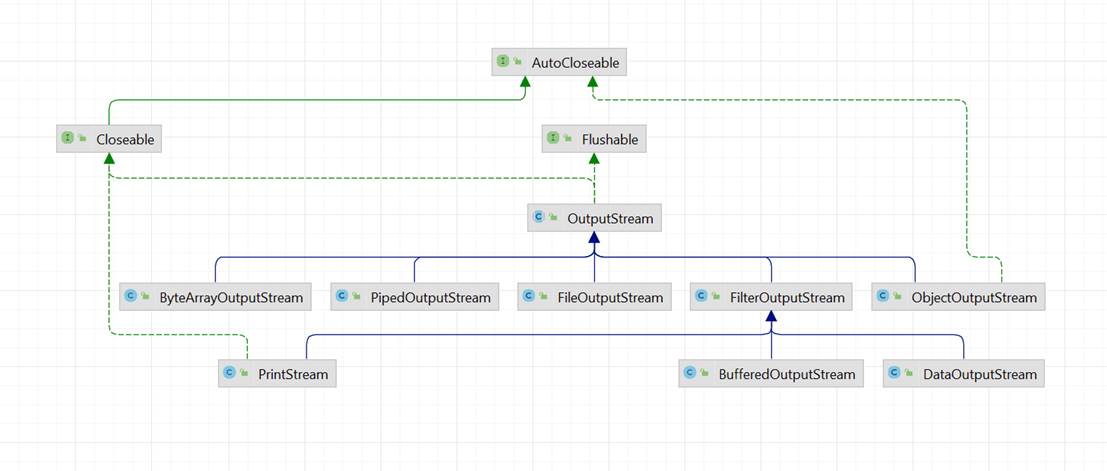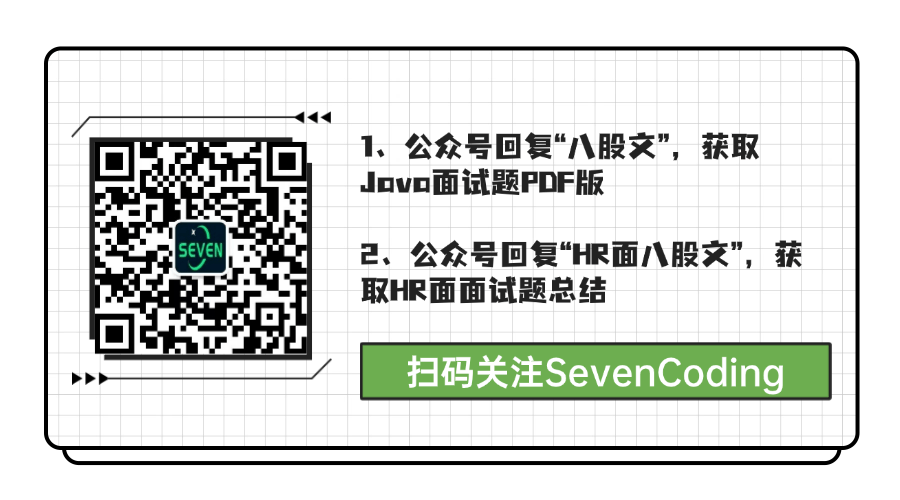OutputStream 类实现关系
OutputStream是输出字节流,具体的实现类层次结构如下:

OutputStream 抽象类
OutputStream 类重要方法设计如下:
// 写入一个字节,可以看到这里的参数是一个 int 类型,对应上面的读方法,int 类型的 32 位,只有低 8 位才写入,高 24 位将舍弃。
public abstract void write(int b)
// 将数组中的所有字节写入,实际调用的是write(byte b[], int off, int len)方法。
public void write(byte b[])
// 将 byte 数组从 off 位置开始,len 长度的字节写入
public void write(byte b[], int off, int len)
// 强制刷新,将缓冲中的数据写入; 默认是空实现,供子类覆盖
public void flush()
// 关闭输出流,流被关闭后就不能再输出数据了; 默认是空实现,供子类覆盖
public void close()底层源码
梳理部分OutputStream及其实现类的源码分析。
OutputStream
OutputStream抽象类源码如下:
public abstract class OutputStream implements Closeable, Flushable {
// JDK11中增加了一个nullOutputStream,即空模式实现,以便可以直接调用而不用判空(可以看如下的补充说明)
public static OutputStream nullOutputStream() {
return new OutputStream() {
private volatile boolean closed;
private void ensureOpen() throws IOException {
if (closed) {
throw new IOException("Stream closed");
}
}
@Override
public void write(int b) throws IOException {
ensureOpen();
}
@Override
public void write(byte b[], int off, int len) throws IOException {
Objects.checkFromIndexSize(off, len, b.length);
ensureOpen();
}
@Override
public void close() {
closed = true;
}
};
}
// 写入一个字节,可以看到这里的参数是一个 int 类型,对应上面的读方法,int 类型的 32 位,只有低 8 位才写入,高 24 位将舍弃。
public abstract void write(int b) throws IOException;
// 将数组中的所有字节写入,实际调用的是write(byte b[], int off, int len)方法
public void write(byte b[]) throws IOException {
write(b, 0, b.length);
}
// 将 byte 数组从 off 位置开始,len 长度的字节写入
public void write(byte b[], int off, int len) throws IOException {
// 检查边界合理性
Objects.checkFromIndexSize(off, len, b.length);
// len == 0 的情况已经在如下的for循环中隐式处理了
for (int i = 0 ; i < len ; i++) {
write(b[off + i]);
}
}
// 强制刷新,将缓冲中的数据写入; 默认是空实现,供子类覆盖
public void flush() throws IOException {
}
// 关闭输出流,流被关闭后就不能再输出数据了; 默认是空实现,供子类覆盖
public void close() throws IOException {
}
}JDK11的空对象模式
举个例子:
public class MyParser implements Parser {
private static Action NO_ACTION = new Action() {
public void doSomething() { /* do nothing */ }
};
public Action findAction(String userInput) {
// ...
if ( /* we can't find any actions */ ) {
return NO_ACTION;
}
}
}然后便可以始终可以这么调用,而不用再判断空了
ParserFactory.getParser().findAction(someInput).doSomething();FilterOutputStream
FilterOutputStream 源码如下
public class FilterOutputStream extends OutputStream {
// 被装饰的实际outputStream
protected OutputStream out;
// 当前stream是否已经被close
private volatile boolean closed;
// close stream时加锁,防止其它线程同时close
private final Object closeLock = new Object();
// 初始化构造函数,传入被装饰的实际outputStream
public FilterOutputStream(OutputStream out) {
this.out = out;
}
// 写入数据,本质调用被装饰outputStream的方法
@Override
public void write(int b) throws IOException {
out.write(b);
}
// 将数组中的所有字节写入
@Override
public void write(byte b[]) throws IOException {
write(b, 0, b.length);
}
// 一个个写入
@Override
public void write(byte b[], int off, int len) throws IOException {
if ((off | len | (b.length - (len + off)) | (off + len)) < 0)
throw new IndexOutOfBoundsException();
for (int i = 0 ; i < len ; i++) {
write(b[off + i]);
}
}
// 强制刷新,将缓冲中的数据写入; 本质调用被装饰outputStream的方法
@Override
public void flush() throws IOException {
out.flush();
}
// 关闭Stream
@Override
public void close() throws IOException {
// 如果已经close, 直接退出
if (closed) {
return;
}
// 加锁处理,如果已经有线程正在closing则退出;
synchronized (closeLock) {
if (closed) {
return;
}
closed = true;
}
// close前调用flush
Throwable flushException = null;
try {
flush();
} catch (Throwable e) {
flushException = e;
throw e;
} finally {
if (flushException == null) {
out.close();
} else {
try {
out.close();
} catch (Throwable closeException) {
// evaluate possible precedence of flushException over closeException
if ((flushException instanceof ThreadDeath) &&
!(closeException instanceof ThreadDeath)) {
flushException.addSuppressed(closeException);
throw (ThreadDeath) flushException;
}
if (flushException != closeException) {
closeException.addSuppressed(flushException);
}
throw closeException;
}
}
}
}
}对比下JDK8中,close方法是没有加锁处理的。这种情况下你可以看JDK8源码中,直接利用java7的try with resources方式,优雅的调用flush方法后对out进行关闭。
public void close() throws IOException {
try (OutputStream ostream = out) {
flush();
}
}ByteArrayOutputStream
ByteArrayOutputStream 源码如下
public class ByteArrayOutputStream extends OutputStream {
// 实际的byte数组
protected byte buf[];
// 数组中实际有效的byte的个数
protected int count;
// 初始化默认构造,初始化byte数组大小为32
public ByteArrayOutputStream() {
this(32);
}
// 初始化byte的大小
public ByteArrayOutputStream(int size) {
if (size < 0) {
throw new IllegalArgumentException("Negative initial size: "
+ size);
}
buf = new byte[size];
}
// 扩容,确保它至少可以容纳由最小容量参数指定的元素数
private void ensureCapacity(int minCapacity) {
// overflow-conscious code
if (minCapacity - buf.length > 0)
grow(minCapacity);
}
// 分配的最大数组大小。
// 由于一些VM在数组中保留一些头字,所以尝试分配较大的阵列可能会导致OutOfMemoryError(请求的阵列大小超过VM限制)
private static final int MAX_ARRAY_SIZE = Integer.MAX_VALUE - 8;
// 扩容的实质方法,确保它至少可以容纳由最小容量参数指定的元素数
private void grow(int minCapacity) {
// overflow-conscious code
int oldCapacity = buf.length;
int newCapacity = oldCapacity << 1;
if (newCapacity - minCapacity < 0)
newCapacity = minCapacity;
if (newCapacity - MAX_ARRAY_SIZE > 0)
newCapacity = hugeCapacity(minCapacity);
buf = Arrays.copyOf(buf, newCapacity);
}
private static int hugeCapacity(int minCapacity) {
if (minCapacity < 0) // overflow
throw new OutOfMemoryError();
return (minCapacity > MAX_ARRAY_SIZE) ?
Integer.MAX_VALUE :
MAX_ARRAY_SIZE;
}
// 写入,写入前确保byte数据长度
public synchronized void write(int b) {
ensureCapacity(count + 1);
buf[count] = (byte) b;
count += 1;
}
public synchronized void write(byte b[], int off, int len) {
Objects.checkFromIndexSize(off, len, b.length);
ensureCapacity(count + len);
System.arraycopy(b, off, buf, count, len);
count += len;
}
public void writeBytes(byte b[]) {
write(b, 0, b.length);
}
public synchronized void writeTo(OutputStream out) throws IOException {
out.write(buf, 0, count);
}
// 重置,显然将实际有效的byte数量置为0
public synchronized void reset() {
count = 0;
}
public synchronized byte[] toByteArray() {
return Arrays.copyOf(buf, count);
}
// 长度,即count
public synchronized int size() {
return count;
}
// 转成string
public synchronized String toString() {
return new String(buf, 0, count);
}
// 转成string,指定的字符集
public synchronized String toString(String charsetName)
throws UnsupportedEncodingException
{
return new String(buf, 0, count, charsetName);
}
public synchronized String toString(Charset charset) {
return new String(buf, 0, count, charset);
}
// 弃用
@Deprecated
public synchronized String toString(int hibyte) {
return new String(buf, hibyte, 0, count);
}
// 对byte 数组而言,close没啥实质意义,所以空实现
public void close() throws IOException {
}
}BufferedOutputStream
BufferedOutputStream 源码如下
public class BufferedOutputStream extends FilterOutputStream {
// Buffered outputStream底层也是byte数组
protected byte buf[];
// 大小,buf[0]到buf[count-1]是实际存储的bytes
protected int count;
// 构造函数,被装饰的outputStream,以及默认buf大小是8192
public BufferedOutputStream(OutputStream out) {
this(out, 8192);
}
public BufferedOutputStream(OutputStream out, int size) {
super(out);
if (size <= 0) {
throw new IllegalArgumentException("Buffer size <= 0");
}
buf = new byte[size];
}
/** Flush the internal buffer */
// 内部的flush方法,将buffer中的有效bytes(count是有效的bytes大小)通过被装饰的outputStream写入
private void flushBuffer() throws IOException {
if (count > 0) {
out.write(buf, 0, count);
count = 0;
}
}
// 写入byte
@Override
public synchronized void write(int b) throws IOException {
// 当buffer满了以后,flush buffer
if (count >= buf.length) {
flushBuffer();
}
buf[count++] = (byte)b;
}
// 将 byte 数组从 off 位置开始,len 长度的字节写入
@Override
public synchronized void write(byte b[], int off, int len) throws IOException {
if (len >= buf.length) {
// 如果请求长度已经超过输出缓冲区的大小,直接刷新输出缓冲区,然后直接写入数据。
flushBuffer();
out.write(b, off, len);
return;
}
if (len > buf.length - count) {
flushBuffer();
}
System.arraycopy(b, off, buf, count, len);
count += len;
}
// flush方法,需要先将buffer中写入,最后在调用被装饰outputStream的flush方法
@Override
public synchronized void flush() throws IOException {
flushBuffer();
out.flush();
}
}BufferedOutputStream的flush和close方法的区别:
- flush()方法:用来刷新缓冲区,刷新后可以再次写出
- close()方法
- 用来关闭流释放资源
- 如果是带缓冲区的流对象的close()方法,不但会关闭流,close()方法还调用了flush()方法,也就是说,在关闭流之前会执行最后一次flush()

